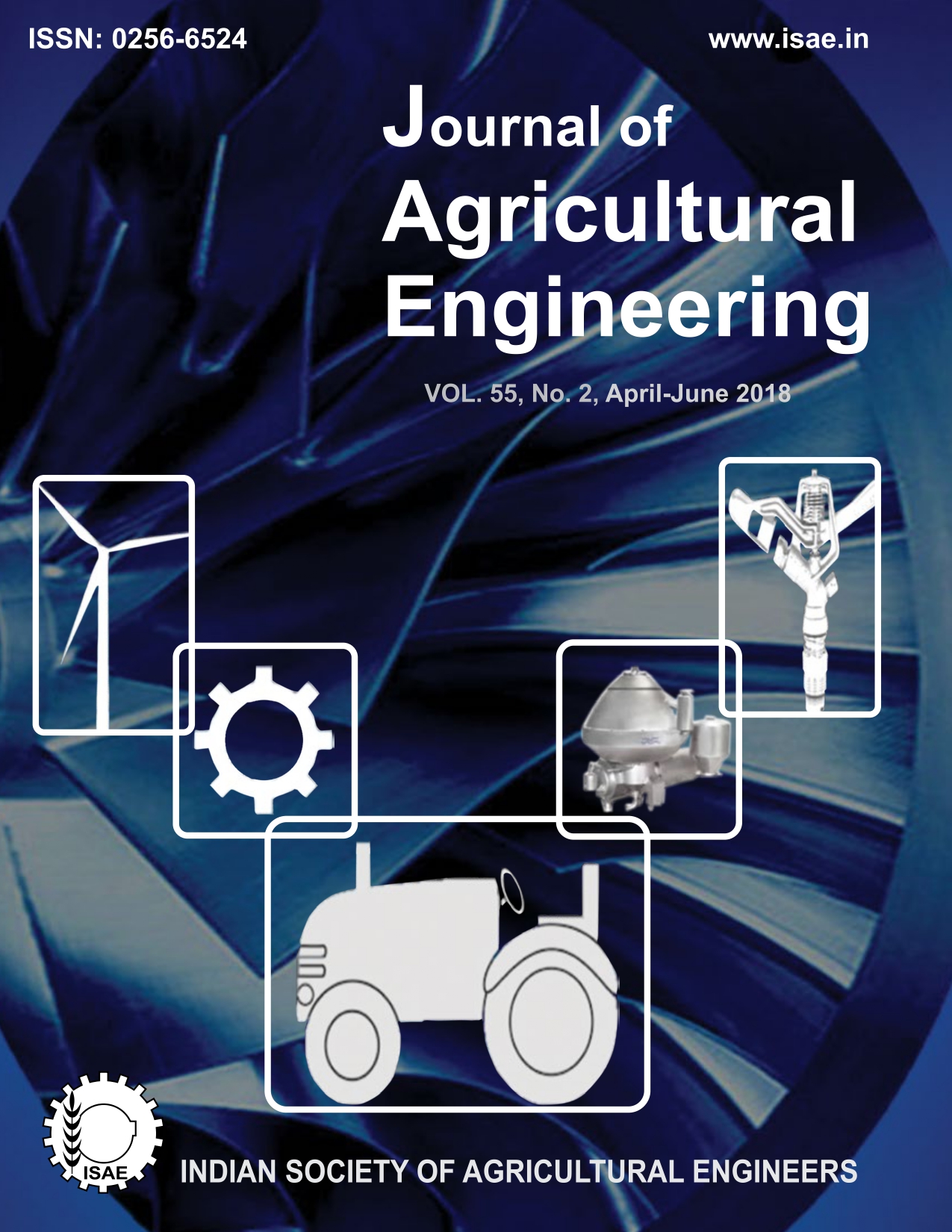Modelling of Root Age Influence on Compressive Strength Properties of Cassava Root
DOI:
https://doi.org/10.52151/jae2018552.1652Keywords:
Compression strength, toughness, stiffness, Cassava cultivar TMS 30572, TME 7Abstract
The influence of root age and moisture content on compressive strength properties of an improved (TMS 30572) and a local (TME 7) cassava cultivar were investigated. Roots harvested at 12, 15 and 18 months after planting (MAP) were used to determine stress at peak, energy to break and Young’s modulus of the roots at moisture contents of 50 %, 55 %, 60 %, 65 % and 70 % (w.b.). Mean stress at peak, energy to break and Young’s modulus of TMS 30572 ranged from 0.61 – 0.88 N.mm-2, 0.89 – 1.13 N.m and 0.92 – 0.84 N.mm-2; 4.80 – 6.67 N.mm-2, 5.99 – 9.21 N.m and 4.55 – 5.11 N.mm-2; and 4.81 – 9.28 N.mm-2, 5.27 – 5.77 N.m and 5.68 – 8.84 N.mm-2at 12, 15 and 18 MAP, respectively. Corresponding values for TME 7 ranged from 0.41 – 1.06 N.mm-2, 0.95 – 1.15 N.m and 1.07 – 1.30 N.mm-2; 3.23 – 8.18 N.mm-2, 5.70 – 8.37 N.m, 5.56 – 8.04 N.mm-2; and 3.22 – 6.96 N.mm-2, 4.25 – 5.58 N.m and 6.69 – 8.38 N.mm-2, respectively. Second-order polynomials described the behaviours of the roots. Root age, and not moisture content, influenced the strength of TME 7 roots, while none of the parameters studied influenced toughness and stiffness (p>0.05). Neither age nor moisture content significantly affected the toughness and stiffness of the roots of the two varieties
References
Adetan D A; Adekoya L O; Makanjuola G A. 2005. An experimental mechanical cassava tuber peeling machine. J.Agric. Eng.Technol., 13, 27-34.
Akintunde B O; Oyawale F A; Tunde-Akintunde T Y. 2005. Design and fabrication of a cassava peeling machine. Niger. Food J., 23, 1-8.
Amoah R S; Sam-Amoah L K; Adu C B; Duah F. 2009. Estimation of the material losses and gari recovery rate during the processing of varieties and age of cassava into gari. Asian J. Agric. Res., 5, 1- 9.
ASAE. 2000. Compression Test of Food Materials of Convex Shape. American Society of Agricultural Engineers Standards S368.4, The Society for Engineering in Agricultural, Food and Biological systems, St. Joseph, MI, USA.
Balasubramanian V M; Sreenarayanan V V; Visvanathan R; Balasubramanian D. 1993. Design, development and evaluation of a cassava chipper. Agric. Mech. Asia Afr. Lat. Am.,24(1), 60-64.
Burns A E; Gleadow R M; Zacarias A M; Cuambe C E; Miller R E; Cavagnaro T E. 2012. Variations in the chemical composition of cassava (Manihot Esculenta Crantz) leaves and roots as affected by genotype and environmental variations. J. Agric. Food Chem., 60(19), 4946- 4956.
FAO. 2014. Africa Food and Agriculture. Food and Agricultural Organisation of the United Nations Statistical Year Book, 2014. www.fao.org/3/a-i3620e. pdf (Accessed 2015).
IFAD. 2008. Improving marketing strategy in Western and Central Africa, Factsheet. http://www. ruralpovertyportal.org (Accessed July 2013).
Ilori O O; Adetan D A. 2013a. A study of the radial compressive cracking force of two cassava varieties. Journal of Food Science and Engineering, 3, 541 - 549.
Ilori O O; Adetan D A. 2013b. A study of the peel penetration pressure of two cassava varieties. Middle- East J.Sci. Res., 16(6), 884-889.
Kolawole O P; Agbetoye L A S; Ogunlowo A S. 2007. Strength and elastic properties of cassava tuber. Int. J. Food Eng., 3(5), 1 - 10.
Nwagugu N I; Okonkwo W I. 2009. Experimental determination of compressive strength of sweet cassava (manihotesculenta). In: Proc. of International Conference of West African Society of Agricultural Engineers and Nigerian Institution of Agricultural Engineers, 191 – 197.
Opara L U. 1999. Cassava Storage. In: CIGR Handbook of Agricultural Engineering, Vol. IV; Processing Engineering (Bakke-Arkema, Ed.), American Society of Agricultural Engineers, St. Joseph MI., 157 – 182.
Oriola K O; Raji A O. 2013. Trends at mechanizing cassava postharvest processing operations. Int. J. Eng. Technol., 3(9), 879 - 887.
Oriola K O; Raji A O. 2015. Compressive strength properties of cassava roots as affected by moisture content. J. Agric. Eng. Technol., 23(1), 48 - 56.
Owhovoriole E N; Oboli S; Mgbeke A C C. 1988. Studies and preliminary design for a cassava tuber peeling machine. Trans.Am.Soc. Agric. Eng., 31(2), 380 - 385.
Safo-Kantanka O; Osei-Minta M. 1996. Effects of cultivar and age at harvest on dry matter, starch gelatinization properties and cooking quality of cassava. Ghana J. Agric. Sci., 28-29, 81 - 89.
Sriroth K; Santisopasri V; Petchalanuwat C; Kurotjanawong K; Piyachomkwan K; Oates C G. 1999. Cassava starch granule structure - function properties: influence of time and conditions at harvest on four cultivars of cassava starch. Carbohydr. Polym., 38, 161-170.














